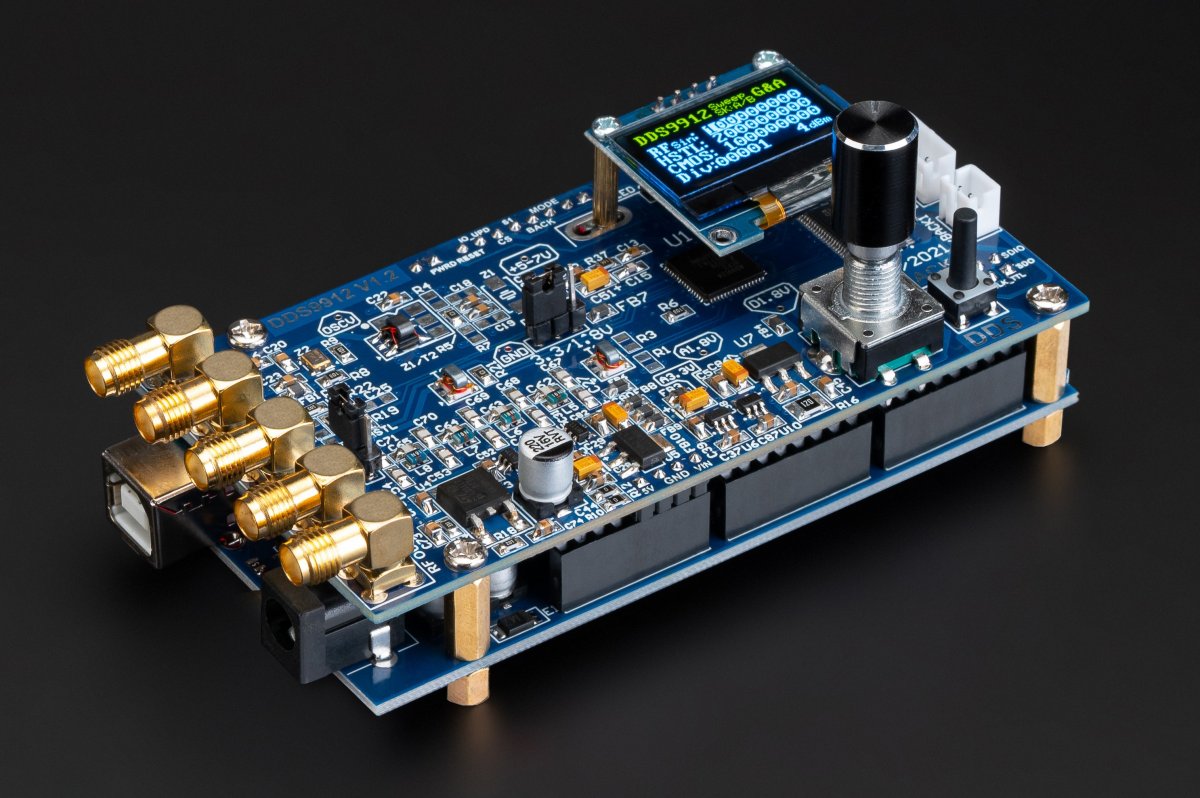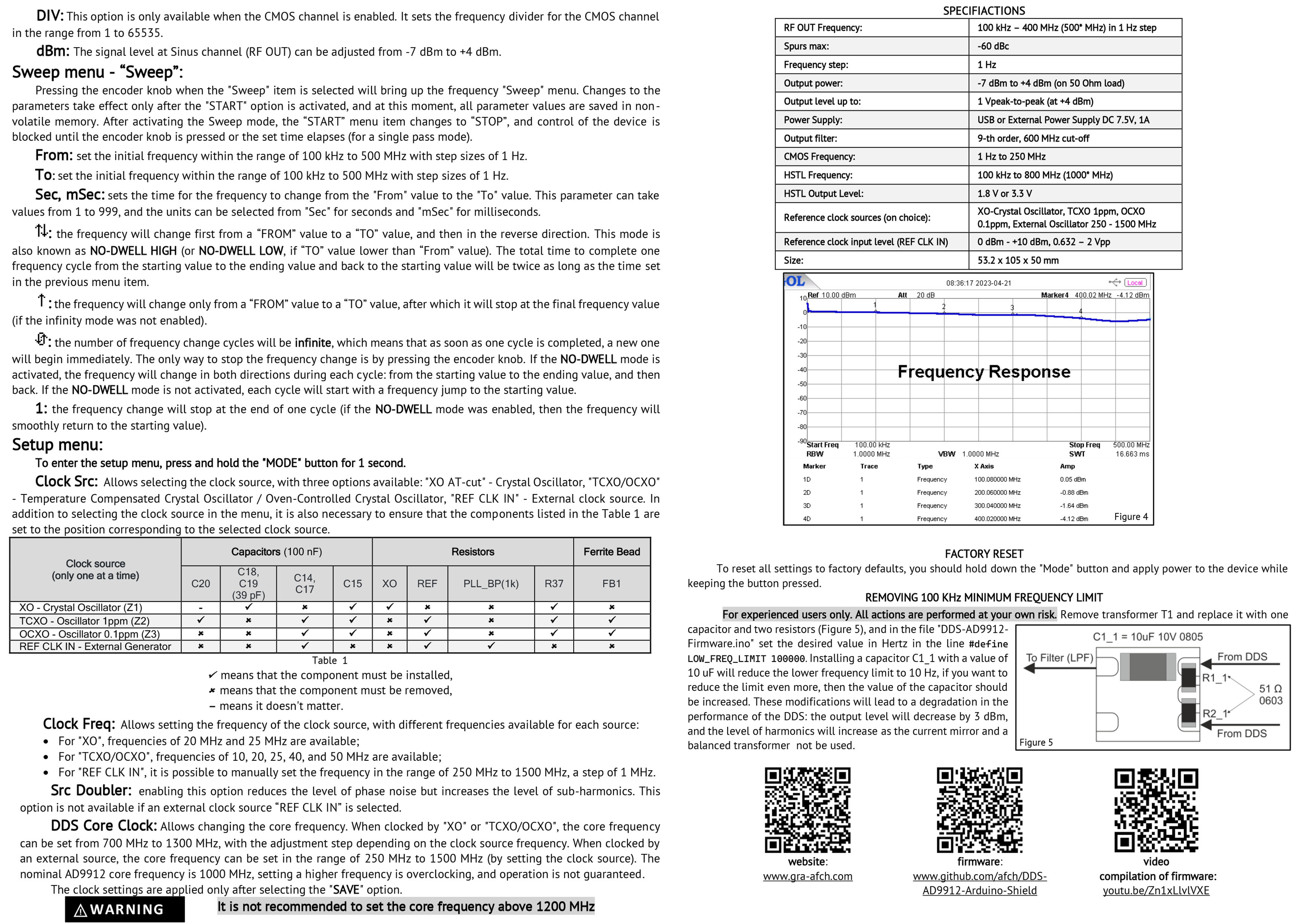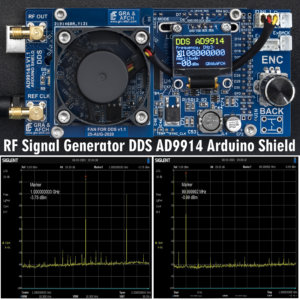DDS AD9912 Arduino Shield RF Signal Generator, Sine-Wave, CMOS, HSTL [600 MHz, @1.3 GHz Core Clock, Low Spurs, Low Harmonic]
Units Sold: 25
DDS (Direct Digital Synthesis) Analog Devices AD9912 Arduino Shield
Easy connection to Arduino MEGA 2560 without additional wires and converters
For maximum performance we recommend Ultra-low noise reference oscillator RCLN1000D-222
All functions of the DDS AD9912 are brought to the contacts of the Arduino MEGA
With this you can fully reveal all the capabilities of the DDS9912 Shield
PCB Design Schematics Case and Software made by GRA & AFCH
$199.95 – $279.95
DDS9912 Arduino Shield RF Signal Generator
DDS (Direct Digital Synthesis) Analog Devices AD9912 Arduino Shield by GRA & AFCH
This device is designed to ensure seamless integration with Arduino MEGA 2560
It does not require any extra wires or converters to work properly
For maximum performance we recommend Ultra-low noise reference oscillator RCLN1000D-222
All AD9912 pins are connected to the Arduino MEGA pins
With this you can fully reveal all the capabilities of the DDS9912 Shield
PCB Design Schematics Case and Software made by GRA & AFCH
Open-source Software available on our GitHub repository: https://github.com/afch/DDS-AD9912-Arduino-Shield
DDS9912 Firmware compilation and uploading to Arduino Mega Tutorial: youtu.be/Zn1xLlvlVXE
Video review of DDS9912 Shield on our YouTube channel: youtu.be/_MUsmr0cAD4

Listing includes:
- RF Unit DDS9912 [DDS9912 Shield Board]
- Display [OLED] (0,94″ or 1,54″) (optional, choose in selector)
- Clock Source (XO, TCXO, EGEN, OCXO) (optional, choose in selector)
- Arduino Control Board [MEGA 2560] (optional, choose in selector)
- Power Supply [DC 7.5V/2A] [US, EU, UK] [AC plug] (optional, choose in selector)
- Operating Instruction
Custom design:
We are offering custom design development for this Unit for 1200$
This comes with condition that at least 10 pieces of them will be ordered then
If you have ANY questions, PLEASE ASK us.
Types of possible reference oscillators (choose one of them in the selector):
- XO – Crystal 25 MHz 20 ppm internal oscillator with PLL at 1 GHz
- TCXO – 50 MHz 1 ppm oscillator PLL x 20 at 1 GHz
- REF CLK IN – external generator up to 1 GHz
(to connect an external clock source of up to 1.3 GHz, the source itself is NOT INCLUDED)
Applications:
- Oscillator Ultra Low Phase Noise Fout=100MHz -154dBc/Hz @ 10khz, Fout=400MHz -145dBc/Hz @ 10khz (external reference clock – RCLN1000D-222)
- Local oscillator (LO) for HAM Radio
- Receiver/Transmitter communications
- Agile local oscillator (LO) frequency synthesis
- For teaching students at Universities and Institutes
- Secure communications
- Test and measurement equipment
Functional features:
- Support of OLED display (selectable in options)
- One encoder for controlling all functions through a graphical menu
- The synthesizer is capable to generate Sine Wave, CMOS and HSTL signals
- Differential HSTL Output up to 1 GHz
- CMOS Output to up to 200 MHz
- The software allows you to select and configure the frequency of the clock generator through the user menu
(without the need to recompile the program) - Any settings can be stored in non-volatile EEPROM memory (located at Arduino Mega)
- Basic settings are applied and saved automatically
- Expanded and convenient DDS Clock source menu
- This Shield Board support overclocking of the AD9912 core up to 1.3 GHz (heatsink is recommended)
- The DDS9912 Shield has the capability to generate a signal with a frequency of up to 600 MHz,
with a core overclocking potential of up to 1.3 GHz (when the output frequency exceeds 400 MHz,
it is recommended to overclock the DDS core for harmonic suppression) - Standard Mode: up to 400 MHz sine wave output, 1 GSPS (1.0 GHz) internal or external clock speed
- Overclocking Mode: up to 600 MHz sine wave output, up to 1.3 GSPS (1.3 GHz) internal or external clock speed
- Output Filter LPF 9-order
- Spur Killer* 2 channels to suppress spurs in the frequency spectrum* (not yet implemented)
- Integrated 14 bit DAC 48 bit frequency tuning word with 4 μHz resolution 0.000004Hz (optional)
Electrical performance:
- Ensured low harmonic level with levels not exceeding -70dBc,
this is due to the use of an output RF transformer for optimal current mirror operation - Low-Noise LDO Stabilizers with separate power supply for all analog and digital lines (1.8V and 3.3V),
they utilizes 8 IC voltage stabilizers; additionally there is an RF Ferrite bead interchange - Additional balancing transformer used for TCXO and REF CLK IN options
- 4 layered PCB with signal lines on Top and Bottom and inner layers Ground and Power
- High-speed decoupling Level converter and TTL 5V matching
- The built-in 50-ohm resistors in the AD9912 chip provide better noise and harmonic performance compared to the AD9910
- Remote control of the DDS Generator through a USB connection and PC using the terminal serial port
Specifications:
| Frequency: | 100 kHz – 400 MHz (600 MHz*) 1 Hz step |
| Spurs max: | -70 dBc |
| Frequency step: | 1 Hz |
| Output power: | +4 dBm to -7 dBm (on 50 Ohm load) |
| Output level up to: | 1 Vpeak-to-peak (at +4 dBm) |
| Power Supply: | USB or External Power Supply 7.5V DC 1A |
| Output filter (LPF): | 9th order (Cut 600 MHz) |
| CMOS Output | up to 200 MHz, Level 1.8/3.3V |
| HSTL Output | up to 750 MHz (1000 MHz*) |
| Reference clock sources (optional): | XO-Crystal Oscillator, TCXO 1ppm, External Oscillator up to 1.3 GHz |
| PCB Size: | 53.26 x 102 mm |
* when overclocking the core to 1.3 GHz
If you have ANY questions, PLEASE ASK us.
Phase Noise:
This parameter is very important and interesting for those who buy and want to use DDS9912 Shield Board.
Since the internal phase noise of DDS is obviously less than that of PLL generators, the final value are highly dependent on the clock source.
In order to achieve the values stated in the datasheet on AD9912, when designing our DDS9912 Arduino Shield, we strictly adhered to all recommendations from Analog Devices:
PCB layout in 4 layers, 8 low-noise voltage regulators for all power lines (3.3V digital, 3.3V analog, 1.8V digital, and 1.8V analog and etc.).
All phase-noise measurements were performed using a PN2060, and we found that our results are very close to the values specified in the AD9912 datasheet.
Phase Noise Comparison for DDS9912 RF Unit Output Using Different Clock Sources

Let’s compare on this diagram the phase noise plots at the output of the DDS9912 when clocked by the internal PLL and when clocked by the reference ultra-low-noise oscillator RCLN1000D-222.
At a 10 kHz offset from the 100 MHz carrier: with the internal PLL system engaged, the phase noise level is -133 dBc/Hz, while with the PLL system disengaged and using external clocking from RCLN1000D-222, the phase noise is -155 dBc/Hz. This means that using an external clock signal from RCLN1000D-222 results in a phase noise that is 22 dBc/Hz better (lower).
For the same output frequency, but at a 1 MHz offset from the carrier, with the internal PLL system engaged, the phase noise level is -131 dBc/Hz, while with the PLL system disengaged and using external clocking, the phase noise is -168 dBc/Hz.
This means that using external clocking results in phase noise that is 37 dBc/Hz better (lower).

Now let’s compare the same phase noise plots, but at a higher output frequency — 400 MHz.
At a 10 kHz offset from the carrier: with the internal PLL system engaged, the phase noise level is -121 dBc/Hz, while with the PLL system disengaged and using external clocking from RCLN1000D-222, the phase noise is -145 dBc/Hz. This means that using an external clock signal from RCLN1000D-222 results in a phase noise that is 24 dBc/Hz better (lower).
For the same output frequency, but at a 1 MHz offset from the carrier, with the internal PLL system engaged, the phase noise level is -119 dBc/Hz, while with the PLL system disengaged and using external clocking, the phase noise is -158 dBc/Hz.
This means that using external clocking results in phase noise that is 39 dBc/Hz better (lower).
Conclusion:
When using an external clock, you can achieve much lower phase noise than with the built-in PLL, and this difference becomes even more pronounced as the output frequency increases.
But do not forget that in order to achieve such results, increased requirements are put forward to the external oscillator.
For maximum performance we recommend our Ultra-low-noise reference oscillator 1GHz RCLN1000D-222.
Ultra Low Noise Reference Oscillator for AD9912 Shield:
RCLN1000D-222 1GHz Ultra Low Phase Noise Reference Oscillator -150 dBc/Hz @ 20kHz
RCLN1000S 1GHz Low Phase Noise Reference Oscillator -139 dBc/Hz @ 10kHz
If you need higher power output:
The simplest method to increase the power is connecting an external RF signal Amplifier, such as the MMIC MRFA89.
It allows obtaining a DDS signal output power of up to +20 dBm.
IMPORTANT: Since the MMIC MRFA89 Amplifier has maximum output power of +20 dBm and gain of 20 dB, the recommended maximum input signal level is 0 dBm.
NOTE: as most amplifiers generate harmonics, it is advised to connect an LPF Filter to the Amplifier output for harmonic suppression.
For example, one from the LPF 7th Order Elliptical series that we offer.
We recommend RF Amplifier and Low-Pass Filter for AD9912 DDS Shield:
RF Amplifier 8-2000 MHz, GAIN = 20 dB, P = +20 dBm MMIC MRFA89 SOT-89 [GOLD PLATED]
OLED Display Menus:

Remote control of DDS Generator through USB connection from PC using the terminal serial port:
List of Serial Port Commands:
Starting with version 1.02, the ability to control via the serial port has been added.
F – Set Frequency in Hz (100000 – 500000000)
H – Set HSTL Output: 0 – OFF, 1 – ON, 2 – Doubler ON
C – Set CMOS Output: 0 – OFF, 1 – ON
D – Set CMOS Divider (1 – 65353)
P – Set Output Power in dBm (-7 – +4)
M – Get Model
E – Enable Outputs (ALL)
S – Shut down Outputs (ALL)
V – Get Firmware Version
h – Help
; – Commands Separator
Example:
F100000;P-2
Set Frequency to 100 kHz, and Output Power to -2 dBm.
Any number of commands in any order is allowed.
Serial Port Settings:
Speed – 115200 Bouds
Data Bits – 8
Stop Bits – 1
Parity – No
DTR – OFF
Windows:
An example of setting up a serial port in the Windows console:
mode COM3 baud=115200 DTR=OFF Data=8
Usage example:
echo F100000000 > COM3
Ubuntu 22.04:
An example of setting up a serial port in the Ubuntu:
sudo usermod -aG dialout $USER_NAME$
sudo chmod a+rw /dev/ttyUSB0
sudo stty -F /dev/ttyUSB0 115200 cs8 ixoff -hupcl -echo
Usage example:
echo “F100000000” > /dev/ttyUSB0

example of command prompt with serial commands for AD9912 DDS RF Unit
DDS AD9912 Arduino Shield Spectrograms:
GRA & AFCH DDS AD9912 Spectrograms:



GRA & AFCH DDS AD9912 Shield Oscillograms CMOS/HSTL:


DDS AD9912 Arduino Shield Thermal images:

DDS AD9912 Shield Board Connection Diagram:

DDS Arduino Shield AD9912 RF Signal Generator by GRA & AFCH:





DDS AD9912 Shield for Arduino by GRA & AFCH:
DDS AD9912 Shield for Arduino Firmware compilation and uploading to Arduino MEGA:
Operating Instruction
If you have ANY questions, PLEASE ASK us.
You may also like…
Low-Pass Filter LPF 7th Order Elliptical 1-1000Mhz 3.5, 7, 14, 28, 144, 433MHz etc for RF Amlifier, Receiver, Transmitter, Mixer, Transceiver, Antenna.
Low-pass Filter is a filter that passes signals with a frequency lower than a selected cutoff frequency
It than also attenuates signals with frequencies higher than the cutoff frequency
These filters are usually applied after RF amplifiers like MMIC, Gain-block and Class C amplifiers
It is used for suppression of high-order harmonics of radio-frequency signals
They can also be placed at the mixer output to filter high frequency interference that plays a role in frequency selection$18.95 – $69.95 Select optionsDIY KIT for DDS AD9959 Arduino Shield RF Signal Generator 4 Synchronized DDS Channels [225MHz, @600 MHz Core Clock, Low Spurs, Low Harmonic]
DIY KIT for DDS (Direct Digital Synthesis) Analog Devices AD9959 4 Synchronized DDS Channels
Arduino Shield Easy connection to Arduino MEGA 2560 without additional wires and converters
All functions of the DDS AD9959 are brought to the contacts of the Arduino MEGA
With this you can fully reveal all the capabilities of the DDS AD9959 Shield
PCB, Design, Schematics, Case and Software made by GRA & AFCH$219.95 – $299.95 Select optionsDIY KIT for DDS AD9910 Shield for Arduino RF Signal Generator AM/FM/SWEEP [600 MHz, @1.5 GHz Core Clock, Low Spurs, Low Harmonic]
DIY KIT for DDS (Direct Digital Synthesis) Analog Devices AD9910 Arduino Shield
Easy connection to Arduino MEGA 2560 without additional wires and converters
For maximum performance we recommend Ultra-low noise reference oscillator RCLN1000
All functions of the DDS AD9910 are brought to the contacts of the Arduino MEGA
With this you can fully reveal all the capabilities of the DDS AD9910 Shield
PCB Design Schematics Case and Software made by GRA & AFCH$199.95 – $279.95 Select optionsRCLN1000C – 1GHz Low Phase Noise Reference Oscillator -136 dBc/Hz @ 10kHz RCLN1000C for AD9910 AD9912 Units
The RCLN1000C Oscillator is built on a VCXO and a high-speed comparator
It generates clean rectangular CMOS signal
This approach enables precise odd-order frequency multiplication
It is implemented in this design by a factor of 5 without introducing additional phase noise
To further improve frequency accuracy the oscillator incorporates a Phase-Locked Loop (PLL)
with a Temperature-Compensated Crystal Oscillator (TCXO) as the reference
It ensuring outstanding stability and reliability across a wide temperature range
$299.95 – $314.95 Select optionsDDS AD9914 Arduino Shield RF Signal Generator [1.4GHz @3.5GHz Core Clock, Low Spurs, Low Harmonic]
DDS (Direct Digital Synthesis) Analog Devices AD9914
Arduino Shield Easy connection to Arduino MEGA 2560 without additional wires and converters
All functions of the DDS AD9914 are brought to the contacts of the Arduino MEGA
With this you can fully reveal all the capabilities of the DDS AD9914 Shield
PCB, Design, Schematics, Case and Software made by GRA & AFCH$699.95 – $904.95 Select optionsDDS AD9959 Arduino Shield RF Signal Generator 4 Synchronized DDS Channels [225MHz, @600 MHz Core Clock, Low Spurs, Low Harmonic]
DDS (Direct Digital Synthesis) Analog Devices AD9959 4 Synchronized DDS Channels
Arduino Shield Easy connection to Arduino MEGA 2560 without additional wires and converters
All functions of the DDS AD9959 are brought to the contacts of the Arduino MEGA
With this you can fully reveal all the capabilities of the DDS AD9959 Shield
PCB, Design, Schematics, Case and Software made by GRA & AFCH$189.95 – $269.95 Select optionsDDS AD9915 Arduino Shield RF Signal Generator [1GHz @3GHz Core Clock, Low Spurs, Low Harmonic]
DDS (Direct Digital Synthesis) Analog Devices AD9915
Arduino Shield Easy connection to Arduino MEGA 2560 without additional wires and converters
All functions of the DDS AD9915 are brought to the contacts of the Arduino MEGA
With this you can fully reveal all the capabilities of the DDS AD9915 Shield
PCB, Design, Schematics, Case and Software made by GRA & AFCH$599.95 – $679.95 Select options





















